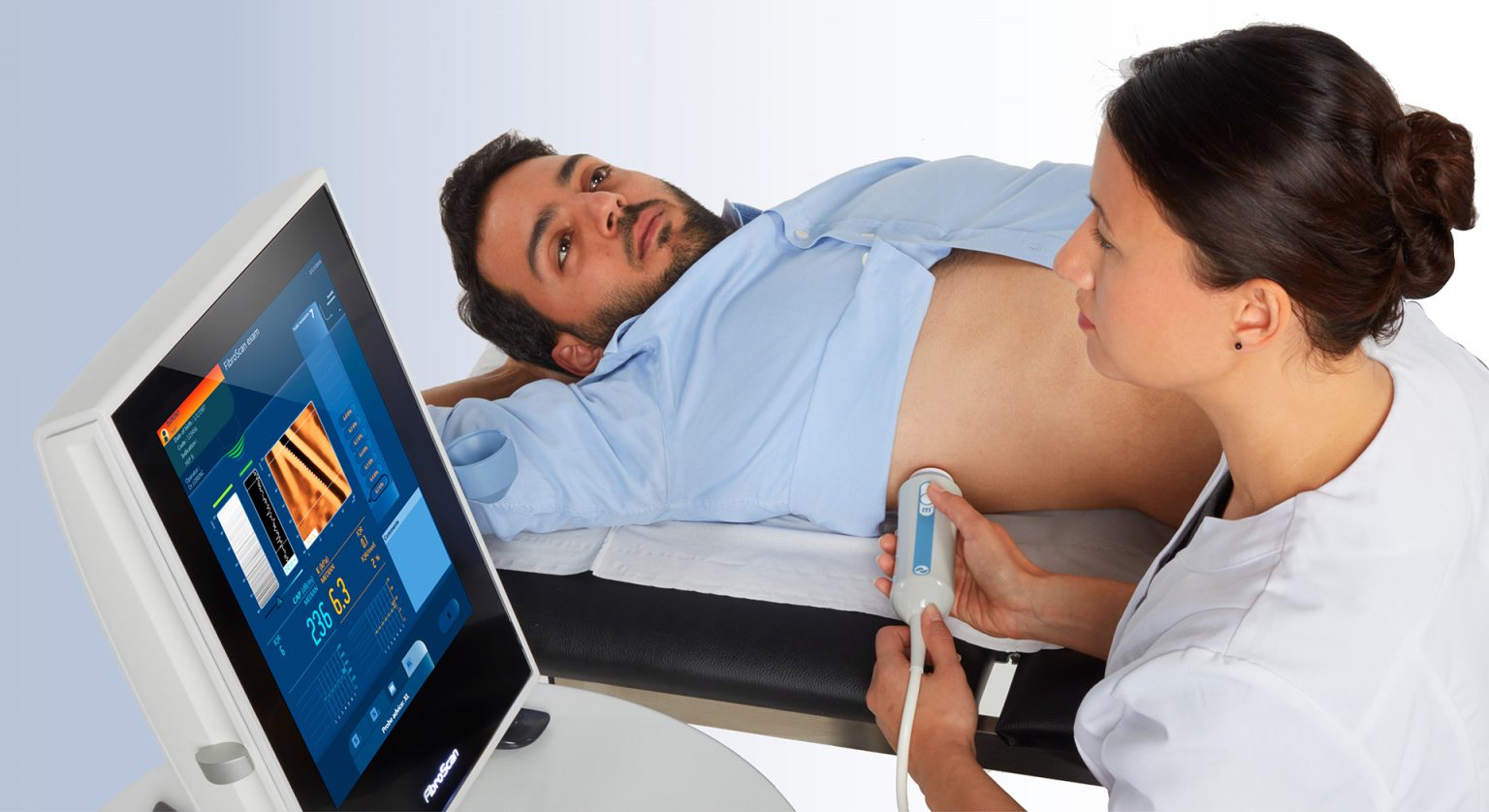Vibration Controlled Transient Elastography(Fibroscan) for detection of Liver Fibrosis and Steatosis

VCTE Fibroscan For Determining Liver Fibrosis
Vibration Controlled Transient Elastography, abbreviated as VCTE, was developed in the year 1992 when it happened to be the first elastography technique from the US. At present, it has emerged as a successful technique to accurately detect conditions, mainly Liver Fibrosis in people with ‘fatty liver disease’ or viral hepatitis. VCTE is also used to evaluate Liver Steatosis and detect the damages caused by Cirrhosis.
Liver – A Vital Organ
The liver is the human body’s largest internal organ, carries out several significant functions throughout the day. Its basic mechanisms include:
- Producing and excreting bile
- Detoxifying as well as purifying blood
- Metabolism of carbohydrates
- Metabolism of proteins and fats
- Excreting cholesterol and drugs
- Excreting bilirubin
- Storing vitamins and minerals
- Activating enzyme
- Synthesising plasma proteins
- Storing vitamins and minerals, etc.
However, hepatologists and gastroenterologists come across numerous cases that involve ‘nonalcoholic fatty liver disease’ or ‘liver disease’. Chronic liver disease can lead to Liver Fibrosis that can turn into ‘Cirrhosis of the liver.’
Liver Fibrosis is the condition in which noticeably big scar tissue is formed inside the liver. This happens when the liver tries to repair and then replace the already damaged cells. The first or initial stage of liver scarring is Fibrosis. When other parts of the liver get severely scarred inside, it’s called liver cirrhosis. Liver Fibrosis is caused mainly due to Viral hepatitis C, alcohol abuse and nonalcoholic fatty liver, and sometimes due to certain drugs or disorders.
The VCTE Fibroscan
Due to certain damaging mechanisms, the liver can get injured, which often leads to Hepatic fibrosis. To understand the condition of liver fibrosis with more accuracy, the VCTE technique is preferred over the customary hepatic histopathology examination or liver biopsy. The American Association for the Study of Liver Diseases endorses Vibration Controlled Transient Elastography (VCTE). The Food and Drug Administration has also approved it for being a non-invasive test for "liver disease".
VCTE – The Procedure
Fibroscan (FS) or Transitional Elastography (TE) is referred to as ‘one-dimensional pulse elastography’ as well. VCTE is done with the help of the Fibroscan device. Fibroscan measures shear wave velocity. In the VCTE procedure, the liver stiffness is measured using signals of pulse-echo ultrasound. The process employs a mechanical vibration pulse and ultrasound wave that works on the measurements of the elasticity or stiffness of a particular tissue.
VCTE, using Fibroscan, functions with a probe (ultrasound transducer), and via low-frequency mild-amplitude vibrations, and creates an elastic shear wave. These are transmitted right through the liver tissues. The probe uses Pulse-echo ultrasound for following the shear wave’s transmission. This is required to measure the velocity (m/s) and provide the liver stiffness measurement (LSM). Kilopascals or kPa is used to express the LSM, and it correlates with the stage of fibrosis.
As the liver stiffness can increase after meals due to postprandial blood flow, Patients are asked to fast for 2 – 3 hours before the test.
Fibroscan Results
Fibroscan helps measure the fibrosis (or scarring) and the steatosis (fat in liver cells or fatty change) inside one’s liver.
The CAP Score measures the liver’s fatty change; this score is used to determine the steatosis grade. It’s measured in dB/m (decibels per meter) and ranges between 100 – 400 dB/m.
The fibrosis result is the measurement of liver scarring. The scarring is measured based on the stiffness of the liver. It’s measured in kPa (kilopascals) and ranges from 2 – 6 kPa.
The healthcare provider uses the patients’ medical history and the Fibroscan fibrosis result and finds out the fibrosis score.
Interpreting the Fibrosis score:
F0 to F1 means no/mild scarring of the liver.
F2 means moderate scarring of the liver.
F3 means severe scarring of the liver.
F4 means cirrhosis or advanced scarring of the liver.
The Advantages Of VCTE Technique:
Besides the detection of Liver Fibrosis, this technique can help in evaluating conditions like Liver Steatosis. Doctors can also use it to identify advanced fibrosis in patients who are suffering from NAFLD or ‘non-alcoholic fatty liver disease’ (as per the practice guidance by the American Association for the Study of Liver Diseases).
Patients need to be evaluated periodically, which becomes convenient with VCTE as it’s a quick process. The range of detection is wide, from 2.5 kPa and 75 kPa.
The technique can be successfully performed even by non-medical persons or professionals, provided they have completed a short Fibroscan learning period which can include (50 – 100 scans). However, only a qualified doctor is eligible to make interpretations of the result.
Why Fibroscan Is More Preferable Than Biopsy:
Liver Biopsy has its own procedural and reliability limitations. It is clearly an invasive process. For this test, the patient needs to be admitted to the hospital. The process is costly. Moreover, Biopsy can be risky for the patient as it can cause pain and bleeding. Also, sometimes sampling error happens in the case of liver biopsies. This is because a very small piece of liver is sampled here, and this can cause incorrect staging of the fibrosis.
On the other hand, Fibroscan is a non-invasive technique. It’s not at all time consuming, as the process takes around 5 to 7 mins time. So it’s a hassle free and quick procedure. The results are given almost immediately. So the clinicians can check the results on the same day, and patients don’t have to visit the clinic repeatedly. And it’s not an expensive test compared to Biopsy. This is a painless test. No IV’s or needles are involved in Fibroscan. This test has no side effects as well.
Conclusion
Hence, VCTE Fibroscan is making its mark every day among the increasing number of Liver Fibrosis patients with its dependable, inexpensive, safe and time saving evaluation procedure.
https://www.ncbi.nlm.nih.gov/pmc/articles/PMC4638155/#:~:text=Vibration%2Dcontrolled%20transient%20elastography%20(VCTE,and%20fatty%20liver%20disease%20populations.
https://www.epainassist.com/abdominal-pain/liver/what-is-a-fibroscan-of-the-liver?gclid=CjwKCAjw47eFBhA9EiwAy8kzND_kNo5w6MKOkNARz3udQTGqRq6a9CzCe5SbweefLZNlcfcCjx0Q0hoCnAcQAvD_BwE
https://www.rnceus.com/lf/lffx.html
https://www.medscape.com/viewarticle/824139
https://www.epainassist.com/abdominal-pain/liver/what-is-a-fibroscan-of-the-liver?gclid=CjwKCAjw47eFBhA9EiwAy8kzNNfNWbW7xLxegi3TuV4O9ppn9SmG5ZZ-Q7L6tl-hIh89jYpGqW_T1RoC8TkQAvD_BwE
https://www.cghjournal.org/article/S1542-3565%2814%2900818-0/fulltext
https://www.intechopen.com/books/liver-biopsy/non-invasive-assessment-of-liver-fibrosis-by-vibration-controlled-transient-elastography-fibroscan-
https://www.lifebeyondhepatitisc.com/2020/10/fibroscan-versu
https://www.msdmanuals.com/en-in/home/liver-and-gallbladder-disorders/fibrosis-and-cirrhosis-of-the-liver/fibrosis-of-the-liver#:~:text=Fibrosis%20is%20the%20formation%20of,cirrhosis%2C%20which%20can%20cause%20symptoms.
https://www.healthline.com/health/liver-fibrosis
https://www.mskcc.org/cancer-care/patient-education/understanding-your-fibroscan-results
https://aasldpubs.onlinelibrary.wiley.com/doi/pdf/10.1002/cld.407
https://www.sciencedirect.com/science/article/pii/S258955592030001X

